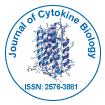Imbalance in pro-inflammatory and anti-inflammatory cytokines
Received: 22-Jan-2022 / Editor assigned: 24-Jan-2022 / Reviewed: 07-Jan-2022 / Revised: 09-Jan-2022 / Accepted Date: 09-Jan-2022 / Published Date: 16-Feb-2022 DOI: 10.4172/2161-0681.1000064
Opinion
An inflammatory cytokine or proinflammatory cytokine is a sort of signaling molecule (a cytokine) that is discharged from immune cells like helper T cells (Th) and macrophages, and certain other cell types that advance inflammation. They incorporate interleukin-1 (IL- 1), IL-12, and IL-18, tumor necrosis factor alpha (TNF-α), interferon gamma (IFNγ), and granulocyte-macrophage settlement animating element (GM-CSF) and assume a significant part in intervening the innate immune response. Inflammatory cytokines are transcendently delivered by and associated with the up regulation of inflammatory reactions.
Cytokines are molecules created by immune cells that instigate the relocation of different cells to sites of infection or injury, promote the production of anti-microbial agents, and signal the production of inflammatory mediators. These occasions are significant fighting infections. However, sometimes this interaction goes unchecked, bringing about unwanted inflammation that can harm tissues and organs.
Excessive chronic production of inflammatory cytokines contributes to inflammatory diseases that have been connected to various diseases, like atherosclerosis and malignant growth. Dysregulation has additionally been connected to depression and other neurological diseases A harmony among proinflammatory and anti-inflammatory cytokines is necessary to maintain health. Aging and exercise additionally assume a part in how much irritation from the arrival of proinflammatory cytokines. Treatments to treat inflammatory diseases incorporate monoclonal antibodies that either neutralizes inflammatory cytokines or their receptors.
T- Helper cells that are available in peripheral tissues are known to be a prominent source of IL17. These cells cooperate with microbial creatures, specifically in the gastrointestinal tract, and are instructed or “induced” to produce and secrete IL17. These inducible, T-aide, IL17- delivering cells are found transcendently at mucosal locales and are significant for keeping up with the strength of these tissues.
Inflammatory cytokines assume a part in starting the inflammatory response and to control the host protection against microorganisms intervening the intrinsic insusceptible reaction. Some inflammatory cytokines have additional roles, for example, going about as development factors. Pro-inflammatory cytokines, for example, IL-1β, IL-6, and TNF-α additionally trigger pathological pain. While IL-1β is delivered by monocytes and macrophages, it is likewise present in nociceptive DRG neurons. IL-6 assumes a part in neuronal reaction to an injury. TNF-α is a well-known proinflammatory cytokine present in neurons and the glia. TNF-α is often involved in different signaling pathways to regulate apoptosis in the cells. Excessive chronic production of inflammatory cytokines contributes to inflammatory diseases that have been connected to different diseases, like atherosclerosis and malignant growth. Dysregulation of proinflammatory cytokines have additionally been connected to discouragement and other neurological diseases. A harmony among proinflammatory and anti-inflammatory cytokines is important to anti-inflammatory cytokines. Aging and exercise additionally assume a part in how much inflammation from the arrival of proinflammatory cytokines [1-3].
Adverse consequences
In cystic fibrosis
A proinflammatory cytokine causes hyperinflammation, the main source of lung tissue annihilation in cystic fibrosis. With such a strong inflammatory response and a raised number of insusceptible cells, lungs of cystic fibrosis patients can’t clear the microbes and become more susceptible to infections. A high prevalence (40-70%) of patients with cystic fibrosis show signs of asthma, possibly due to the primary deficiency in the cystic fibrosis trans membrane conductance regulator (CFTR).[13] CFTR-deficient T-helper cells create an inflammatory environment that has high concentrations of TNF-α, IL-8, and IL-13, which contributes to increased contractility of airway smooth muscle [4,5].
References
- Arita Y, Park HJ, Cantillon A, Verma K, Menon R, et al. (2020) Pro- and anti-inflammatory effects of sulforaphane on placental cytokine production. J Reprod Immunol 780-789.
- Porro C, Gioia SD, Trotta T, Lepore S, Panaro MA, et al. (2013) Pro-inflammatory effect of cystic fibrosis sputum microparticles in the murine lung. J Cyst Fibros 721-728.
- Mao R, Zhang C, Chen J, Zhao G, Zhou R, et al. (2018) Different levels of pro- and anti-inflammatory cytokines in patients with unipolar and bipolar depression. J Affect Disord 65-72.
- Conti P, D’Ovidio C, Conti C, Gallenga CE, Lauritano D, et al. Progression in migraine: Role of mast cells and pro-inflammatory and anti-inflammatory cytokines. Eur. J. Pharmacol 844: 87-94.
- Gill D, Veltkamp R (2016) Dynamics of T cell responses after stroke. Curr Opin Pharmacol 26-32.
Indexed at, Google Scholar, Crossref
Indexed at, Google Scholar, Crossref
Indexed at, Google Scholar, Crossref
Citation: Kiran R (2022) Imbalance in pro-inflammatory and anti-inflammatory cytokines. J Cytokine Biol 7: 064. DOI: 10.4172/2161-0681.1000064
Copyright: © 2022 Kiran R. This is an open-access article distributed under the terms of the Creative Commons Attribution License, which permits unrestricted use, distribution, and reproduction in any medium, provided the original author and source are credited.
Select your language of interest to view the total content in your interested language
Share This Article
Recommended Journals
Open Access Journals
Article Tools
Article Usage
- Total views: 2428
- [From(publication date): 0-2022 - Dec 08, 2025]
- Breakdown by view type
- HTML page views: 1790
- PDF downloads: 638
